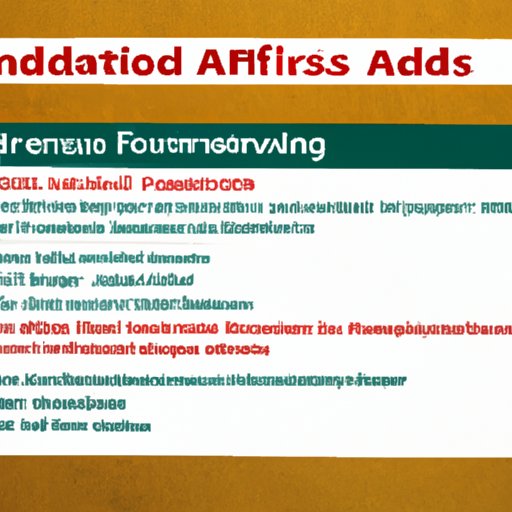Introduction
Financial aid is a type of funding provided to students to help them pay for higher education. It can come from the federal government, state governments, colleges and universities, or private organizations. The purpose of this article is to provide an overview of the basics of paying with financial aid and to identify appropriate uses of financial aid funds.
Explaining the Basics of Paying with Financial Aid
The first step in understanding how to pay with financial aid is to understand what financial aid is and the different types of aid available.
What is Financial Aid?
Financial aid is money that is provided to students to help them pay for their college education. This money can come from the federal government, state governments, colleges and universities, or private organizations. Financial aid is typically need-based and is awarded based on a student’s academic performance, financial need, and other criteria.
Types of Financial Aid
Financial aid can come in several forms, including grants, scholarships, loans, and work-study programs. Grants and scholarships are typically need-based and do not need to be repaid. Loans must be repaid, usually with interest. Work-study programs are a form of employment that allows students to work part-time while attending school and earn money to help pay for their education.
Qualifying for Financial Aid
In order to qualify for financial aid, students must complete the Free Application for Federal Student Aid (FAFSA). The FAFSA is used to determine a student’s eligibility for federal, state, and institutional financial aid. Students must also meet certain criteria such as having a minimum GPA, being enrolled in an eligible program of study, and demonstrating financial need.

Detailing How to Access and Utilize Financial Aid Funds
Once a student has been determined to be eligible for financial aid, they must then apply for the aid and receive their award.
Applying for Financial Aid
Students must complete the FAFSA in order to be considered for financial aid. They must also provide additional documentation such as tax returns, bank statements, and proof of enrollment. Once the application is complete, it will be reviewed by the financial aid office at the school the student is attending.
Receiving Financial Aid Awards
Once the application is reviewed, the student will receive a financial aid award letter. This letter will detail the amount of aid the student is eligible for and the type of aid (grants, loans, etc.). The student must then accept the award before they can begin utilizing the funds.
Accepting Financial Aid Awards
In order to accept a financial aid award, the student must sign and return the award letter to the school’s financial aid office. They must also complete any additional paperwork required by the school. Once the award is accepted, the student can begin using the funds to pay for their education.

Identifying Appropriate Uses of Financial Aid Funds
Financial aid funds can be used for a variety of educational expenses. These include tuition, fees, books, supplies, equipment, room and board, and transportation. The funds cannot be used for personal expenses such as entertainment, clothing, or travel.
Tuition and Fees
Financial aid funds can be used to pay for tuition and fees at the school the student is attending. This includes tuition for classes, lab fees, and any other mandatory fees assessed by the school.
Books, Supplies, and Equipment
Financial aid funds can also be used to purchase books, supplies, and equipment related to a student’s course of study. This includes textbooks, notebooks, calculators, computers, software, and other items needed for the student’s academic program.
On-Campus Room and Board
Financial aid funds can also be used to pay for on-campus room and board. This includes the cost of living in a school-owned residence hall and meal plans offered by the school.
Transportation Costs
Financial aid funds can also be used to pay for transportation costs associated with attending school. This includes the cost of public transportation, gas for a vehicle, parking permits, and other transportation-related expenses.

Outlining Payment Options Available When Using Financial Aid
Once a student has accepted their financial aid award, they must decide how they want to receive the funds. There are several payment options available when using financial aid funds.
Direct Deposit
One option is to have the funds deposited directly into the student’s bank account. This is the quickest and most secure method of receiving funds.
Paper Check
Another option is to receive a paper check. This may take longer than direct deposit, but it is still a viable option.
Credit Card
Some schools offer the option of using a credit card to pay for expenses. This is convenient but may come with additional fees.
Cash Payments
Some schools also offer the option of making cash payments for tuition and other expenses. This can be done in person at the school’s business office or through an online payment system.
Online Payment Systems
Many schools offer online payment systems that allow students to pay for tuition and other expenses with their financial aid funds. These systems are typically secure and easy to use.
Comparing Different Financial Aid Programs
There are several different types of financial aid programs available to students. It is important to compare these programs in order to find the one that best suits the student’s needs.
Federal Student Aid
Federal student aid is provided by the U.S. Department of Education and is available to students who meet certain criteria. This aid is typically need-based and is awarded on the basis of the student’s academic performance, financial need, and other criteria.
State Student Aid
State student aid is provided by individual states and is available to students who meet certain criteria. This aid is typically need-based and is awarded on the basis of the student’s academic performance, financial need, and other criteria.
Institutional Student Aid
Institutional student aid is provided by colleges and universities and is available to students who meet certain criteria. This aid is typically need-based and is awarded on the basis of the student’s academic performance, financial need, and other criteria.
Private Student Aid
Private student aid is provided by private organizations and is available to students who meet certain criteria. This aid is typically merit-based and is awarded on the basis of the student’s academic performance, community service, and other criteria.
Conclusion
Financial aid is an important tool for helping students pay for their higher education. In order to make the most of their financial aid funds, students must understand the basics of paying with financial aid, know how to access and utilize their funds, and identify appropriate uses of their funds. Additionally, they must compare different financial aid programs in order to find the one that best suits their needs.
Summary of Key Points
Financial aid is money that is provided to students to help them pay for their college education. In order to receive financial aid, students must complete the FAFSA and meet certain criteria. Financial aid funds can be used to pay for tuition, fees, books, supplies, equipment, room and board, and transportation. There are several payment options available when using financial aid funds, including direct deposit, paper checks, credit cards, cash payments, and online payment systems. Finally, students should compare different financial aid programs in order to find the one that best suits their needs.
Final Thoughts
Financial aid funds can be a great resource for students as they pursue their higher education goals. By understanding the basics of paying with financial aid, identifying appropriate uses of funds, and comparing different programs, students can make the most of their financial aid funds.
(Note: Is this article not meeting your expectations? Do you have knowledge or insights to share? Unlock new opportunities and expand your reach by joining our authors team. Click Registration to join us and share your expertise with our readers.)
